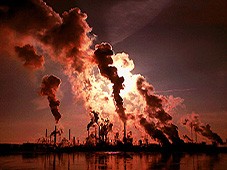

Las principales problemáticas del aire que pueden dañar su salud y al medioambiente son:
-Air Polution-
The six main pollutants:
Smog. Ozone not only damages our health but also vegetation and the ecosystem, including forests, parks and vegetation.
Matter Particles: They are composed of small particles including acids, chemicals, metals and dust. Once the air is inhaled, these particles can affect the heart, lungs and cause serious health problems.Monóxido de Carbono
Nitrogen oxides
Sulfur dioxide
Lead: Lead is persistent in the environment and accumulates in soils and sediments through deposition from air sources, direct discharge of waste streams to bodies of water, mining and erosion. Ecosystems near sources of lead show a wide range of adverse effects that include losses in biodiversity, changes in composition, where growth and reproduction rates of plants and animals were reduced, with neurological effects on vertebrates.
There are certain pollutants that produce gases or particles and generate problems inside a building. Inadequate ventilation, high temperatures and humidity levels can increase the concentration of these gases and particles.
For adequate indoor air quality, strict control must be carried out on the type of solvents, paints and adhesives used; on humidity, leaks, spills and drains, among others.
Gases that trap heat in the atmosphere are called greenhouse gases. There are emissions and absorption of major greenhouse gases to and from the atmosphere.
How strongly do they affect the global temperature?
Some gases are more effective than others in making the planet warmer.
For each greenhouse gas, a Global Warming Potential (GWP) has been calculated to reflect the time it remains in the atmosphere, on average, and the intensity with which it absorbs energy. Gases with a higher atmospheric heating potential absorb more energy, per pound, than gases with a low atmospheric heating potential, and therefore contribute more to global warming.
Acid Rain
"Acid rain" is a term that refers to a mixture of wet and dry deposition of the atmosphere that contains higher values than normal amounts of nitric and sulfuric acids. Precursors, or chemical precursors, result in the formation of acid rain from natural sources, such as volcanoes and decaying vegetation. Others, such as man-made sources, mainly sulfur dioxide (SO2) emissions and oxides of nitrogen (NOx) resulting from the combustion of fossil fuels.
In the United States, approximately 2/3 of all SO2 and 1/4 of all NO come from the generation of electrical energy that depends on the burning of fossil fuels, such as coal.
Acid rain occurs when these gases react in the atmosphere with water, oxygen and other chemicals to form various acidic compounds.
